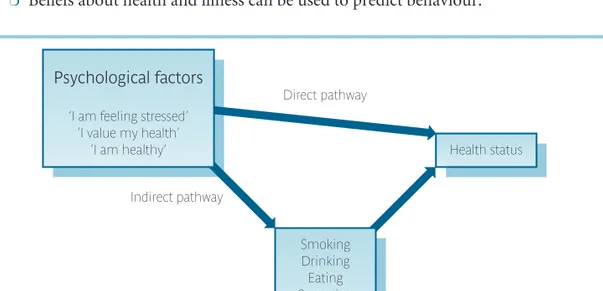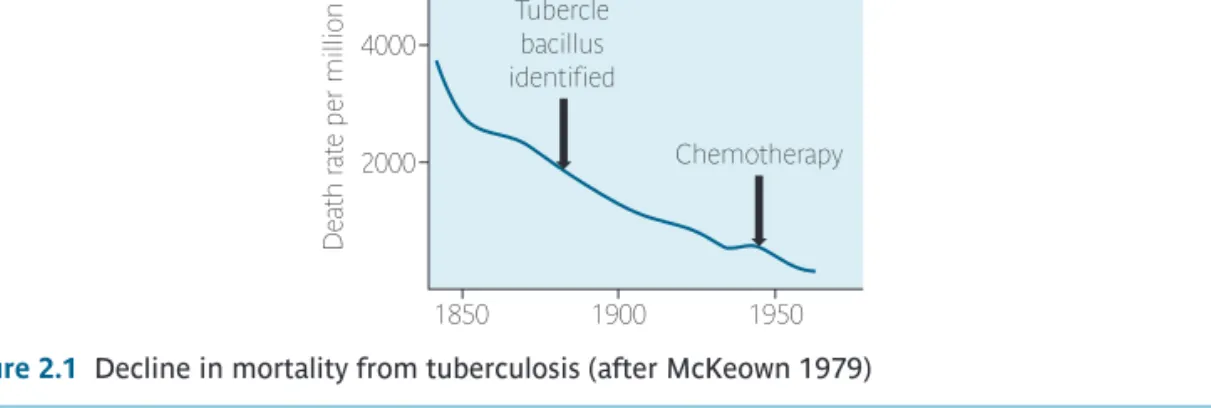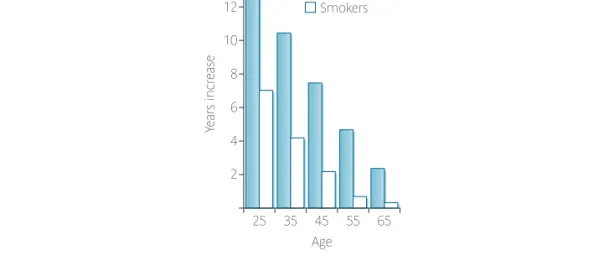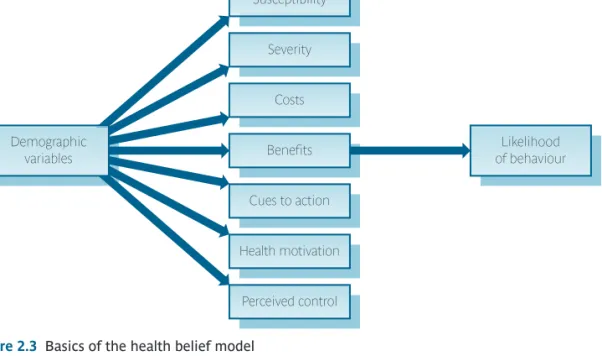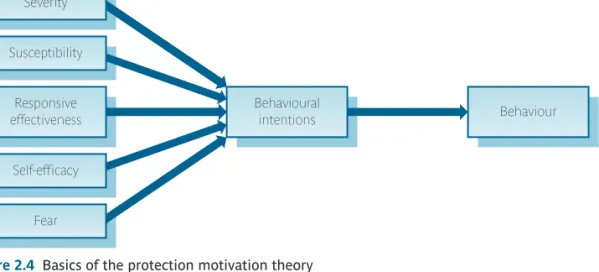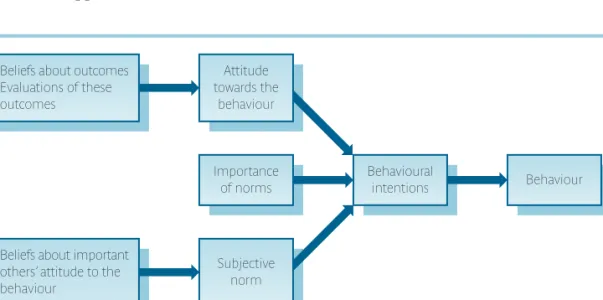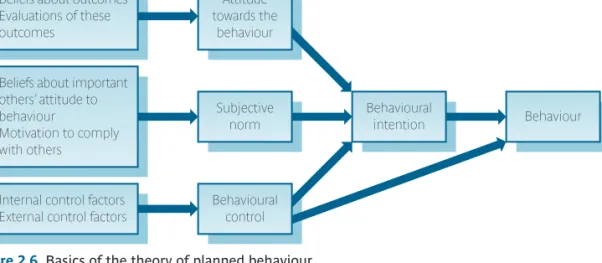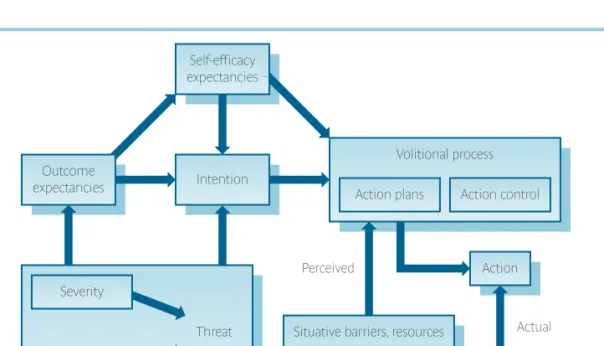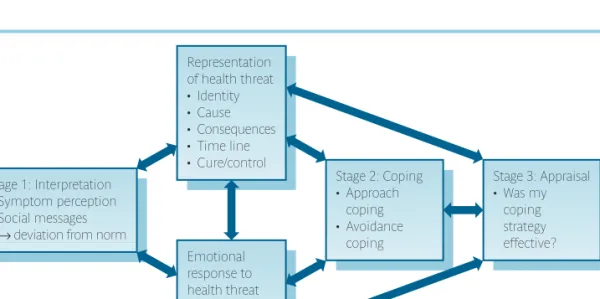a textbook
Fourth Edition
Jane Ogden
a textbook Fourth Edition Jane Ogden
It remains clearly written and highly accessible and still deserves its place as the number one choice of health psychology textbook.” – John Weinman, King’s College, London
The market leading textbook in the field, Health Psychology by Jane Ogden, is essential reading for all students and researchers of health psychology.
It is also invaluable to students of medicine, nursing and allied health.
Retaining the breadth of coverage, clarity and relevance that has made it a favourite with students and lecturers, this fourth edition has been thoroughly revised and updated.
New Features:
• New chapter on women's health issues, exploring recent research into pregnancy, miscarriage, birth, menopause and related areas
• New “Some problems with…” boxes analyse health psychology research and identify the shortcomings and limitations of research in the area
• Updated “Focus on Research” examples introduce contemporary topics and emerging areas for research in health psychology, including exercise, smoking and pain
• The new edition includes new data, graphs and further reading plus suggestions about where you can access the most recent publications and other data
• Revised end-of-chapter review questions for independent study and revision Online Learning Centre: www.openup.co.uk/ogden
The OLC hosts web links and multiple choice questions for students, plus supporting teaching resources for lecturers.
Interested in accessing more research readings? Essential Readings in Health Psychology by Jane Ogden is a new collection of key papers brought together for the first time in one volume which complements Health Psychology: a textbook and offers more detailed accounts of the issues covered in this text.
Jane Ogden is Professor in Health Psychology at the University of Surrey, UK. Her research explores aspects of health including obesity and eating behaviour, communication in the consultation and women's health issues.
Designed By Grosvenor (Northampton) Ltd.
Health Psychology
Health Psychology
A Textbook
F OURTH E DITION
Jane Ogden
Open University Press
Open University Press McGraw-Hill Education McGraw-Hill House Shoppenhangers Road Maidenhead
Berkshire England SL6 2QL
email: [email protected] world wide web: www.openup.co.uk
and Two Penn Plaza, New York, NY 10121-2289, USA First published 2007
Copyright © Jane Ogden 2007
All rights reserved. Except for the quotation of short passages for the purposes of criticism and review, no part of this publication may be reproduced, stored in a retrieval system, or transmitted, in any form or by any means, electronic, mechanical, photocopying, recording or otherwise, without the prior written permission of the publisher or a licence from the Copyright Licensing Agency Limited. Details of such licences (for reprographic reproduction) may be obtained from the Copyright Licensing Agency Ltd of Saffron House, 6-10 Kirby Street, London, EC1N 8TS.
A catalogue record of this book is available from the British Library ISBN-13: 978 0 335 22263 6 (pb) 978 0 335 22264 3 (hb)
ISBN-10: 0 335 22263 3 (pb) 0 335 22264 1 (hb) Library of Congress Cataloging-in-Publication Data CIP data applied for
Typeset by Wearset Ltd, Boldon, Tyne and Wear
Printed and bound in Spain by Mateu Cromo Artes Graficas
Detailed table of contents vi
List of figures and tables x
List of abbreviations xii
Preface to the fourth edition xv
Guided tour xxv
Technology to enhance learning and teaching xxix
Acknowledgements xxxiii
1 An introduction to health psychology 1
2 Health beliefs 13
3 Illness cognitions 47
4 Health professional–patient communication and the role of health
beliefs 73
5 Smoking and alcohol use 95
6 Eating behaviour 127
7 Exercise 157
8 Sex 173
9 Screening 199
10 Stress 221
11 Stress and illness 239
12 Pain 271
13 Placebos and the interrelationship among beliefs, behaviour and
health 293
14 HIV and cancer: psychology throughout the course of illness (1) 311 15 Obesity and coronary heart disease: psychology throughout the course
of illness (2) 333
16 Women’s health issues 365
17 Measuring health status: from mortality rates to quality of life 393
18 The assumptions of health psychology 405
Methodology glossary 409
References 411
Index 477
Brief table of contents
v
List of figures and tables x
List of abbreviations xii
Preface to the fourth edition xv
Guided tour xxv
Technology to enhance learning and
teaching xxix
Acknowledgements xxxiii
1 An introduction to health psychology 1
Chapter overview 1
The background to health psychology 1 What is the biomedical model? 2
The twentieth century 2
What are the aims of health
psychology? 5
What is the future of health
psychology? 6
What are the aims of this book? 7
The contents of this book 8
The structure of this book 9
Questions 10
For discussion 10
Further reading 10
2 Health beliefs 13
Chapter overview 13
What are health behaviours? 13 Why study health behaviours? 14 Lay theories about health 17 Predicting health behaviours 17 Some problems with . . . health beliefs
research 23
Cognition models 23
Focus on research 2.1: Testing a
theory – predicting sexual behaviour 28
Social cognition models 29
Problems with the models 34
To conclude 43
Questions 43
For discussion 43
Assumptions in health psychology 44
Further reading 44
3 Illness cognitions 47
Chapter overview 47
What does it mean to be healthy? 47 What does it mean to be ill? 49 What are illness cognitions? 49 Some problems with . . . illness
cognitions research 52
Leventhal’s self-regulatory model of
illness cognitions 52
Why is the model called
self-regulatory? 54
Focus on research 3.1: Testing a theory – illness representations and
behavioural outcomes 55
Stage 1: Interpretation 56
Stage 2: Coping 60
The positive interpretation of illness 67 Using the self-regulatory model to
predict outcomes 67
To conclude 71
Questions 71
For discussion 71
Assumptions in health psychology 71
Further reading 72
4 Health professional–patient communication and the role of
health beliefs 73
Chapter overview 73
What is compliance? 74
Predicting whether patients are
compliant: the work of Ley 74 How can compliance be improved? 76 Focus on research 4.1: Testing a
theory – patient satisfaction 77 The wider role of information in illness 79 Some problems with . . . communication
research 80
The role of knowledge in health
professional–patient communication 81 The problem of doctor variability 82
To conclude 92
Questions 92
For discussion 92
Assumptions in health psychology 93
Further reading 93
5 Smoking and alcohol use 95
Chapter overview 95
Who smokes? 95
Who drinks? 96
Health implications of smoking and
alcohol use 98
What is an addiction? 100
Historical changes in attitude and
theoretical approach 100
Detailed table of contents
vi
DETAILED TABLE OF CONTENTS vii
What is the second disease concept? 102 Problems with a disease model of
addiction 103
What is the social learning
perspective? 104
Some problems with . . . smoking and
alcohol research 106
The stages of substance use 106 Stages 1 and 2: Initiating and
maintaining an addictive behaviour 107 Stage 3: The cessation of an addictive
behaviour 109
Focus on research 5.1: Testing a
theory – stages of smoking cessation 111 Interventions to promote cessation 112 Focus on research 5.2: Putting theory into practice – worksite smoking ban 118 Stage 4: Relapse in smoking and
drinking 120
A cross-addictive behaviour
perspective 122
To conclude 125
Questions 125
For discussion 125
Assumptions in health psychology 126
Further reading 126
6 Eating behaviour 127
Chapter overview 127
What is a healthy diet? 127
How does diet affect health? 129 Who eats a healthy diet? 129 Developmental models of eating
behaviour 130
Cognitive models of eating behaviour 137 Some problems with . . . eating
research 140
A weight concern model of eating
behaviour 140
The causes of body dissatisfaction 141
Social factors 141
Psychological factors 143
Dieting 145
Focus on research 6.1: Testing a
theory – overeating as a rebellion 153
To conclude 156
Questions 156
For discussion 156
Further reading 156
7 Exercise 157
Chapter overview 157
Developing the contemporary
concern with exercise behaviour 157
What is exercise? 158
Who exercises? 158
Some problems with . . . exercise
research 159
Why exercise? 159
Focus on research 7.1: Testing a
theory – exercise and mood 163 What factors predict exercise? 164 Focus on research 7.2: Testing a
theory – predicting exercise 169
Exercise relapse 170
To conclude 171
Questions 171
For discussion 171
Assumptions in health psychology 171
Further reading 172
8 Sex 173
Chapter overview 173
Developing the contemporary
research perspectives on sex 173 Some problems with . . . sex research 182 Sex as a risk in the context of
STDs/HIV and AIDS 182
Focus on research 8.1: Testing a theory – the situation and
condom use 189
The broader social context 191
To conclude 196
Questions 196
For discussion 196
Assumptions in health psychology 197
Further reading 197
9 Screening 199
Chapter overview 199
What is screening? 199
The history of the screening ethos 200 Screening as a useful tool 201 Guidelines for screening 202 Psychological predictors of the
uptake of screening 202
Some problems with . . . screening
research 203
Focus on research 9.1: Testing a
theory – predicting screening 206 Screening as problematic 208
To conclude 218
Questions 218
For discussion 218
Assumptions in health psychology 218
Further reading 219
10 Stress 221
Chapter overview 221
What is stress? 221
The development of stress models 222 A role for psychological factors in
stress 225
Some problems with . . . stress
research 228
Stress and changes in physiology 228
Measuring stress 230
Focus on research 10.1: Putting
theory into practice 233
The interaction between psychological and physiological aspects of stress 234
To conclude 236
Questions 236
For discussion 236
Assumptions in health psychology 236
Further reading 237
11 Stress and illness 239
Chapter overview 239
Does stress cause illness? 239 Stress and changes in behaviour 241 Stress and changes in physiology 244 Individual variability in the
stress–illness link 245
Psychoneuroimmunology 246
Some problems with . . . stress and
illness research 252
The impact of chronic stress 252 Which factors moderate the
stress–illness link? 255
Coping 255
Social support 259
Focus on research 11.1: Testing a
theory – social support and health 261
Personality 262
Control 264
Control and social support in stress
and illness 266
To conclude 268
Questions 268
For discussion 268
Assumptions in health psychology 268
Further reading 269
12 Pain 271
Chapter overview 271
What is pain? 271
Early pain theories – pain as a
sensation 272
Including psychology in theories of
pain 272
The gate control theory of pain 273 Some problems with . . . pain research 275 The role of psychosocial factors in
pain perception 276
Subjective–affective–cognitive
processes 276
Focus on research 12.1: The experience
of pain 281
The role of psychology in pain
treatment 282
Focus on research 12.2: Putting theory into practice – treating chronic pain 285 The outcome of pain treatment and management: a role for pain
acceptance? 288
Measuring pain 289
To conclude 290
Questions 290
For discussion 290
Assumptions in health psychology 291
Further reading 291
13 Placebos and the interrelationship among beliefs, behaviour and health 293
Chapter overview 293
What is a placebo? 294
A history of inert treatments 294
How do placebos work? 295
Some problems with . . . placebo
research 299
The central role of patient
expectations 299
Cognitive dissonance theory 300 Focus on research 13.1: Testing a
theory – ‘doing as you’re told’ as a
placebo 301
The role of placebo effects in health
psychology 306
To conclude 309
Questions 309
For discussion 309
Assumptions in health psychology 310
Further reading 310
14 HIV and cancer: psychology
throughout the course of illness (1) 311
Chapter overview 311
HIV and AIDS 311
The role of psychology in the study
of HIV 313
Some problems with . . . HIV and
cancer research 319
Focus on research 14.1: Testing a theory – psychology and immune
functioning 320
Cancer 322
Focus on research 14.2: Putting theory into practice – treating cancer
symptoms 328
To conclude 331
Questions 331
For discussion 331
Assumptions in health psychology 331
Further reading 332
15 Obesity and coronary heart disease:
psychology throughout the course of
illness (2) 333
Chapter overview 333
Obesity 333
What is obesity? 334
How common is obesity? 336
What are the problems with obesity? 336
What causes obesity? 337
Some problems with . . . obesity and
CHD research 345
Obesity treatment 346
Should obesity be treated at all? 348
Conclusion 352
Coronary heart disease (CHD) 353 Focus on research 15.1: Testing a
theory – the consequences of
disease 356
To conclude 362
Questions 362
For discussion 362
Assumptions in health psychology 362
Further reading 363
16 Women’s health issues 365
Chapter overview 365
Miscarriage 365
Termination of pregnancy 369 Some problems with . . . women’s
health research 376
Pregnancy and birth 377
The transition into motherhood 380 Focus on research 16.1: Exploring
experience – the transition
into motherhood 382
Problems with research exploring
pregnancy and birth 383
The menopause 384
To conclude 391
Questions 391
For discussion 391
Assumptions in health psychology 391
Further reading 392
17 Measuring health status: from
mortality rates to quality of life 393
Chapter overview 393
Mortality rates 393
Morbidity rates 394
Measures of functioning 394
Subjective health status 394 What is quality of life? 395 Focus on research 17.1: Putting
theory into practice – evaluating hip
replacement surgery 398
A shift in perspective 400
Using quality of life in research 400 Some problems with . . . health status
research 401
To conclude 403
Questions 403
For discussion 403
Assumptions in health psychology 403
Further reading 404
18 The assumptions of health
psychology 405
Chapter overview 405
The assumptions of health
psychology 405
Studying a discipline 407
Further reading 408
Methodology glossary 409
References 411
Index 477
DETAILED TABLE OF CONTENTS ix
List of figures and tables
Figures
1.1 The biopsychosocial model of health and illness 4
1.2 Psychology and health: direct and indirect pathways 5
2.1 Decline in mortality from tuberculosis 15
2.2 The effect of smoking on increase in expectation of life: males, 1838–1970 16
2.3 Basics of the health belief model 24
2.4 Basics of the protection motivation theory 27
2.5 Basics of the theory of reasoned action 30
2.6 Basics of the theory of planned behaviour 31
2.7 The health action process approach 32
3.1 Leventhal’s self-regulatory model of illness behaviour 53
3.2 Coping with the crisis of illness 62
4.1 Ley’s model of compliance 74
4.2 A simplified model of problem solving 83
4.3 Diagnosis as a form of problem solving 84
5.1 Changes in smoking, 1974–2004 96
5.2 Current smokers, ex-smokers and non-smokers by sex, 1972–92 97 5.3 Adults drinking more than the recommended guidelines on at least one day last
week, by age and sex, 2004 (GB) 97
5.4 Deaths attributable to smoking 98
5.5 Alcohol-related deaths in the UK since 1991 99
5.6 The stages of substance use 106
5.7 Relapse curves for individuals treated for heroin, smoking and alcohol addiction 120
5.8 The relapse process 121
5.9 Relapse prevention intervention strategies 122
6.1 The balance of good health 128
6.2 A developmental, cognitive and weight concern model of eating behaviour 130
6.3 Social eating 132
6.4 Measuring body dissatisfaction 141
6.5 Overeating in dieters in the laboratory 146
6.6 A boundary model explanation of overeating in dieters 148 6.7 A comparison of the boundaries for different types of eaters 148
6.8 The ‘what the hell’ effect as a form of relapse 151
6.9 From dieting to overeating 152
7.1 Participation in sport in the past 12 months (2003) 159
7.2 Mortality and fitness levels in individuals with a BMI > 25.4 161 8.1 Percentage using no contraception at first intercourse, by age at first intercourse 177 8.2 Contraception use at first intercourse in those aged 16–24 177 8.3 Changes in the use of condoms as the usual method of contraception by age,
1983–91 184
9.1 Costs per potential cancer prevented for different screening policies 212
x
10.1 Selye’s three-stage general adaptation syndrome 222
10.2 The role of appraisal in stress 226
10.3 Stress and changes in physiology 229
10.4 The interaction between psychological and physiological aspects of stress 235
11.1 Chronic/acute model of stress–illness link 240
11.2 Stress-diathesis model 241
11.3 The stress–illness link: physiological moderators 246
11.4 The stress–illness link: psychological moderators 255
11.5 Incidence of CHD by number of children: the role of work stress on illness in
women 266
12.1 The gate control theory of pain 273
12.2 Psychosocial aspects of pain 276
12.3 Psychology and pain treatment 283
13.1 The central role of patient expectations in placebo effects 300 13.2 Totman’s cognitive dissonance theory of placebo effects 304 13.3 The interrelationship between beliefs, behaviour and health 306
14.1 The potential role of psychology in HIV 314
14.2 The potential role of psychology in cancer 323
15.1 Potential role of psychology in obesity 334
15.2 Grades of obesity by height and weight 335
15.3 Relationship between BMI and mortality 337
15.4 Changes in physical activity and obesity 341
15.5 Changes in food intake from the 1950s to the 1990s 342
15.6 Changes in calorie consumption and obesity 343
15.7 The potential role of psychology in CHD 353
16.1 Rates of miscarriage that require a hospital stay vary by age of mother 368
16.2 Abortion rate in England and Wales by age, 2005 370
16.3 Worldwide abortion rates 371
16.4 Worldwide rates of unsafe abortions 371
16.5 Home birth rates 1961–2004 in the UK 378
16.6 The frequency and severity of menopausal symptoms 385
16.7 The menopause as a biopsychosocial event 386
17.1 A shift in perspective in measuring health 399
Tables
3.1 Adaptive tasks 63
3.2 Coping tasks 64
LIST OF FIGURES AND TABLES xi
List of abbreviations
ADL activity of daily living
AIDS acquired immune deficiency syndrome APT adjuvant psychological therapy
AVE abstinence violation effect BDI Beck depression inventory BMI body mass index
BSE breast self-examination CAD coronary artery disease
CAM complementary and alternative medicines CBSM cognitive behavioural stress management CBT cognitive behavioural therapy
CFQ child feeding questionnaire CHD coronary heart disease
CIN cervical intraepithelial neoplasia
CISQ condom influence strategy questionnaire CMV cytomegalovirus
COPD chronic obstructive pulmonary disease CR conditioned response
CS conditioned stimulus D&C dilatation and curettage
DAFNE dose adjustment for normal eating DEBQ Dutch eating behaviour questionnaire DVT deep vein thrombosis
ERPC evacuation of the retained products of conception FAP familial adenomatous polyposis
FH familial hypercholesterolaemia GAS general adaptation syndrome GCT gate control theory
CHQ general health questionnaire GSR galvanic skin response
HAART highly active anti-retroviral therapy HADS hospital anxiety and depression scale HAPA health action process approach HBM health belief model
HPA hypothalamic-pituitary-adrenocorticol HRT hormone replacement therapy
IPA interpretative phenomenological analysis IPQ illness perception questionnaire
IPQR revised version of illness perception questionnaire LISRES life stressors and social resources inventory MAT medication adherence training
MHLC multidimensional health locus of control MI myocardial infarction
xii
MPQ McGill pain questionnaire MACS Multi Centre AIDS Cohort Study NHP Nottingham health profile NHS National Health Service NKCC natural killer cell cytotoxicity PDA personal digital assistant
PFSQ parental feeding style questionnaire PMT protection motivation theory PSE present state examination PSS perceived stress scale RCT random controlled trial
SEIQoL schedule for the individual quality of life SES socio-economic status
SEU subjective expected utility SIP sickness impact profile SLQ silver lining questionnaire SOS Swedish Obese Subjects study SRE schedule of recent experiences SRRS social readjustment rating scale STD sexually transmitted diseases TOP termination of pregnancy TPB theory of planned behaviour TRA theory of reasoned action UR unconditioned response US unconditional stimulus WHO World Health Organization WRAP Women, Risk and AIDS Project
LIST OF ABBREVIATIONS xiii
Why I first wrote this book
I first wrote this book in 1995 after several years of teaching my own course in health psychol- ogy. The texts I recommended to my students were by US authors and this was reflected in their focus on US research and US health care provision. In addition, they tended to be driven by examples rather than by theories or models which made them difficult to turn into lectures (from my perspective) or to use for essays or revision (from my students’ perspective). I decided to write my own book to solve some of these problems. I wanted to supplement US work with that from my colleagues from the UK, the rest of Europe, New Zealand and Australia. I also wanted to emphasize theory and to write the book in a way that would be useful. I hope that the first three editions have succeeded.
Aims of this new fourth edition
The third edition involved a fairly major revision and involved strengthening the book’s coverage of the more biological aspects of health psychology, particularly pain, stress and PNI. These are the areas I am personally less involved in and the previous editions had reflected my own research interests with their emphasis on behaviour. This fourth edition has tried to do two things. First, it has updated the book throughout, adding new theories and research studies wherever appropri- ate. It is surprising how quickly research can look dated to a student in their twenties. In particular I have tried to reflect the increasing use of qualitative methodologies within health psychology by adding qualitative examples when they have been central to the literature being discussed. I have also tried to encourage a more critical and analytical approach to research by highlighting prob- lems where appropriate. Second, this edition includes a new chapter on women’s health issues with a focus on miscarriage, termination, pregnancy and birth and the menopause. Some of this reflects my own areas of research interests. More than this, however, it also reflects the interests of my undergraduate and postgraduate students who are predominantly women and are interested in the areas of health that pertain to them. This chapter does not aim to cover all issues relevant to women but those that have been covered in most depth by the research community. Perhaps in the next edition I may even add a chapter on men’s health – who knows!
Also in this edition, I have added the following in response to review feedback on the third edition:
■ A new feature called ‘Some problems with . . .’ This is a short box that appears in each chapter, asking students to consider some of the issues surrounding research in a particular area of health psychology. For example, Chapter 2 considers some problems with health beliefs research. In this case, how do we know that asking people about health beliefs doesn’t change the way they think? Is it possible that beliefs that predict and explain behaviour are different to those that change behaviour? And so on. The aim of including these examples is to encourage students to develop an awareness of some common pitfalls of research in health psychology and to engage them in challenging, evaluating and analysing the integrity of their own research and those of other academics in the field.
Preface to the fourth edition
xv
■ New research focus examples. There is some exciting new research under way in health psychology and it is important that students are exposed to new studies and understand that health psychology is a dynamic discipline. Some examples of the new research excerpts include a study to explore the role of coherence in promoting the intentions to quit smoking (2004) in Chapter 3, using the theory of planned behaviour to predict exercise (2005) in Chapter 7, and an abstract about how people experience chronic benign back pain (Smith 2007). There are many other new examples interspersed within the book.
■ New data, references, further reading and review questions. Finally, as you would expect from a new revision, there is a full update throughout, including new data and figures where appropriate, updated Further Reading sections at the end of each chapter featuring new and recent publications, a comprehensively updated List of References at the end of the text, and new questions at the end of chapters for use either in class as discussion points or as an aid to student learning.
■ An Online Learning Centre website accompanies this edition with useful materials for stu- dents of health psychology and their lecturers, including Powerpoint presentations, artwork and more.
For more information about the new edition’s features, see the Guided Tour on pages xix–xxi, which leads you through the textbook chapters from introduction to chapter conclusion and questions.
The structure of the fourth edition
Health psychology is an expanding area in terms of teaching, research and practice. Health psy- chology teaching occurs at both the undergraduate and postgraduate level and is experienced by both mainstream psychology students and those studying other health-related subjects. Health psychology research also takes many forms. Undergraduates are often expected to produce research projects as part of their assessment, and academic staff and research teams carry out research to develop and test theories and to explore new areas. Such research often feeds directly into practice, with intervention programmes aiming to change the factors identified by research. This book aims to provide a comprehensive introduction to the main topics of health psychology. The book will focus on psychological theory supported by research. In addition, how these theories can be turned into practice will also be described. This book is now sup- ported by a comprehensive website which includes teaching supports such as lectures and assessments.
Health psychology focuses on the indirect pathway between psychology and health which emphasizes the role that beliefs and behaviours play in health and illness. The contents of the first half of this book reflect this emphasis and illustrate how different sets of beliefs relate to behaviours and how both these factors are associated with illness.
Chapters 2–4 emphasize beliefs. Chapter 2 examines changes in the causes of death over the twentieth century and why this shift suggests an increasing role for beliefs and behaviours. The chapter then assesses theories of health beliefs and the models that have been developed to describe beliefs and predict behaviour. Chapter 3 examines beliefs that individuals have about illness and Chapter 4 examines health professionals’ health beliefs in the context of health professional–patient communication.
Chapters 5–9 examine health-related behaviours and illustrate many of the theories and constructs that have been applied to specific behaviours. Chapter 5 describes theories of
addictive behaviours and the factors that predict smoking and alcohol consumption. Chapter 6 examines theories of eating behaviour drawing upon developmental models, cognitive theories and the role of weight concern. Chapter 7 describes the literature on exercise behaviour both in terms of its initiation and methods to encourage individuals to continue exercising. Chapter 8 examines sexual behaviour and the factors that predict self-protective behaviour both in terms of pregnancy avoidance and in the context of HIV. Chapter 9 examines screening as a health behaviour and assesses the psychological factors that relate to whether or not someone attends for a health check and the psychological consequences of screening programmes.
Health psychology also focuses on the direct pathway between psychology and health and this is the focus for the second half of the book. Chapter 10 examines research on stress in terms of its definition and measurement and Chapter 11 assesses the links between stress and illness via changes in both physiology and behaviour and the role of moderating variables. Chapter 12 focuses on pain and evaluates the psychological factors in exacerbating pain perception and explores how psychological interventions can be used to reduce pain and encourage pain acceptance. Chapter 13 specifically examines the interrelationships between beliefs, behaviour and health using the example of placebo effects. Chapters 14 and 15 further illustrate this inter- relationship in the context of illness, focusing on HIV and cancer (Chapter 14) and obesity and coronary heart disease (Chapter 15). Chapter 16 examines women’s health issues and the role of psychology in understanding women’s experiences of miscarriage, termination, pregnancy, birth and the menopause, and highlights how the mode of treatment of intervention can affect these experiences. Chapter 17 explores the problems with measuring health status and the issues surrounding the measurement of quality of life.
Finally, Chapter 18 examines some of the assumptions within health psychology that are described throughout the book.
PREFACE TO THE FOURTH EDITION xvii
Essential Readings in Health Psychology edited by Jane Ogden
ISBN: 9780335211388 (Softback) 9780335211395 (Hardback) Forthcoming in 2007 and available from www.mcgraw-hill.co.uk
Jane Ogden has also produced a new text, a reader in health psychology, containing 29 papers that employ different theories and methods and offer a more in-depth approach to the discip- line. Covering the breadth of topics dealt with in this textbook, the reader aims to provide a range of good case examples of health psychology work. By reading them, students of psychol- ogy should gain a greater insight into what health psychology research can (and cannot) achieve. Throughout, the papers are framed by editorial discussions of their context, meaning and contribution to Health Psychology as a whole.
This textbook has provided the structure for choosing the papers in the reader. The papers have been grouped into five parts, covering the context of health psychology, health behaviours, health care, stress and health, and chronic illness. The reader can therefore be used as an adjunct to this textbook to provide more detail than that covered in a more general introduc- tory text such as this one. In fact some of the papers selected for the reader are referenced in the textbook in brief in the Focus on Research boxes.
However, the structure of the reader also follows the key areas highlighted by the British Psychological Society as central to health psychology and as such would be an ideal resource for any undergraduate or postgraduate course, presenting good examples of key theories, models and methods. It could also provide the starting point for a reading list to accompany an under- graduate or postgraduate course or the papers could be used to focus a seminar discussion or a journal club. In addition, the papers are published in their entirety, including their reference lists, so they can be used to develop reading lists and recommend further reading. Below is the list of papers in Essential Readings in Health Psychology:
Section 1: The context of health psychology
Mokdad, A.H., Marks, J.S., Stroup, D.F. and Gerberding, J.L. (2004) Actual causes of death in the United States, 2000, JAMA, 10(29): 1238–45.
Kaplan, R.M. (1990) Behaviour as the central outcome in health care, American Psychologist, 45:
1211–20.
Section 2: Health behaviours
Sutton, S. (1998) Predicting and explaining intentions and behaviour: how well are we doing?
Journal of Applied Social Psychology, 28: 1317–38
Ogden, J. (2003) Some problems with social cognition models: a pragmatic and conceptual analysis, Health Psychology, 22(4): 424–8.
West, R. (2005) Time for a change: putting the Transtheoretical (Stages of Change) model to rest, Addiction, 100: 1036–9.
Also available: Essential Readings in Health Psychology
xix
Armitage, C.J. (2005) Can the Theory of Planned Behaviour predict the maintenance of phys- ical activity? Health Psychology, 24(3): 235–45.
Murgraff, V., White, D. and Phillips, K. (1999) An application of protection motivation theory to riskier single occasion drinking, Psychology and Health, 14: 339–50.
DiClemente, C.C., Prochaska, J.O., Fairhurst, S.K. et al. (1991) The process of smoking cessa- tion: an analysis of precontemplation, contemplation, and preparation stages of change, Journal of Consulting and Clinical Psychology, 59: 295–304.
Wardle, J. and Beales, S. (1988) Control and loss of control over eating: an experimental inves- tigation, Journal of Abnormal Psychology, 97: 35–40.
Woodcock, A., Stenner, K. and Ingham, R. (1992) Young people talking about HIV and AIDS:
Interpretations of personal risk of infection, Health Education Research: Theory and Practice, 7: 229–34.
Aiken, L.S., West, S.G., Woodward, C.K., Reno, R.R. and Reynolds, K.D. (1994) Increasing screening mammography in asymptomatic women: evaluation of a second generation, theory based program, Health Psychology, 13: 526–38.
Gollwitzer, P.M. and Sheeran, P. (2006) Implementation intentions and goal achievement: a meta-analysis of effects and processes, Advances in Experimental Social Psychology, 38: 69–119.
Section 3: Health care
Roter, D.L., Steward, M., Putnam, S.M. et al. (1997) Communication pattern of primary care physicians, Journal of the American Medical Association, 277: 350–6.
Mead, N. and Bower, P. (2000) Patient centredness: a conceptual framework and review of empirical literature, Social Science and Medicine, 51: 1087–110.
Marteau, T.M., Senior, V., Humphries, S.E. et al. (2004) Psychological impact of genetic testing for familial hypercholesterolemia within a previously aware population: A randomized con- trolled trial, American Journal of Medical Genetics, 128(A): 285–93.
Horne, R. and Weinman, J. (2002) Self regulation and self management in asthma: exploring the role of illness perceptions and treatment beliefs in explaining non adherence to preventer medication, Psychology and Health, 17: 17–32.
Simpson, S.H., Eurich, D.T., Majumdar, S.R., Padwal, R.S., Tsuyuki, R.T., Varney, J. and Johnson, J.A. (2006) A meta-analysis of the association between adherence to drug therapy and mortality, British Medical Journal, July 1, 333(7557): 15.
Section 4: Stress and health
Everson, S.A., Lynch, J.W., Chesney, M.A. et al. (1997) Interaction of workplace demands and cardiovascular reactivity in progression of carotid atherosclerosis: population based study, British Medical Journal, 314: 553–8.
Pereira, D.B., Antoni, M.H., Danielson, A. et al. (2003) Life stress and cervical squamous intraepithelial lesions in women with human papillomavirus and human immunodeficiency virus, Psychosomatic Medicine, 65(1): 1–8.
Ebrecht, M., Hextall, J., Kirtley, L.G., Taylor, A., Dyson, M. and Weinman, J. (2004) Perceived stress and cortisol levels predict speed of wound healing in healthy male adults, Psycho- neuroendocrinology, 29: 798–809.
Pennebaker, J.W. (1997) Writing about emotional experiences as a therapeutic process, Psycho- logical Science, 8(3): 162–6.
Petrie, K.J., Booth, R.J. and Pennebaker, J.W. (1998) The immunological effects of thought sup- pression, Journal of Personality and Social Psychology, 75: 1264–72.
Section 5: Chronic illness
Eccleston, C., Morley, S., Williams, A., Yorke, L. and Mastroyannopoulou, K. (2002) Systematic review of randomised controlled trials of psychological therapy for chronic pain in children and adolescents with a subset meta-analysis of pain relief, Pain, 99(1–2): 157–65.
Smith, J.A. (in press) Pain as an assault on the self: an interpretative phenomenological analysis of the psychological impact of chronic benign low back pain, Psychology and Health.
Taylor, S.E. (1983) Adjustment to threatening events: a theory of cognitive adaptation, Ameri- can Psychologist, 38: 1161–73.
Petrie, K.J., Cameron, L.D., Ellis, C.J., Buick, D. and Weinman, J. (2002) Changing illness perceptions after myocardial infarction: an early intervention randomized controlled trial.
Psychosomatic Medicine, 64: 580–6.
Antoni, M.H., Carrico, A.W., Duran, R.E. et al. (2006) Randomized clinical trial of cognitive behavioral stress management on human immunodeficiency virus viral load in gay men treated with highly active anti retroviral therapy, Psychosomatic Medicine, 68: 143–51.
Ogden, J., Clementi, C. and Aylwin, S. (2006) The impact of obesity surgery and the paradox of control: a qualitative study, Psychology and Health, 21(2): 273–93.
Rapkin, B.D. and Schwartz, C.E. (2004) Towards a theoretical model of quality of life appraisal:
Implications of findings from studies of response shift, Health and quality of life outcomes, 2: 14.
If you wish to use the reader as a supplementary text alongside this textbook, we have provided a list of chapters of Health Psychology 4th Edition alongside the related papers from the reader.
Please note that many of the 29 papers appear below more than once because they can be used with several chapters of the textbook:
ALSO AVAILABLE: ESSENTIAL READINGS IN HEALTH PSYCHOLOGY xxi
Chapter in Health Psychology: Corresponding papers in A Reader in Health Psychology A Textbook, Fourth Edition (alphabetical by first author)
Chapter 1 An introduction Kaplan, R.M. (1990)
to health psychology Mokdad, A.H., Marks, J.S., Stroup, D.F. and Gerberding, J.L. (2004) Chapter 2 Health beliefs Aiken, L.S., West, S.G., Woodward, C.K., Reno, R.R. and
Reynolds, K.D. (1994) Armitage, C.J. (2005)
DiClemente, C.C., Prochaska, J.O., Fairhurst, S.K. et al. (1991) Gollwitzer, P.M. and Sheeran, P. (2006)
Kaplan, R.M. (1990)
Mokdad, A.H., Marks, J.S., Stroup, D.F. and Gerberding, J.L. (2004) Murgraff, V., White, D. and Phillips, K. (1999)
Ogden, J. (2003)
Simpson S.H. et al. (2006) Sutton, S. (1998)
Wardle, J. and Beales, S. (1988) West, R. (2005)
Woodcock, A., Stenner, K. and Ingham, R. (1992)
Chapter 3 Illness cognitions Antoni, M.H. et al. (2006) Horne, R. and Weinman, J. (2002) Marteau, T.M. et al. (2004) Pennebaker, J.W. (1997)
Petrie, K.J., Cameron, L.D., Ellis, C.J., Buick, D. and Weinman, J. (2002) Simpson S.H. et al. (2006)
Taylor, S.E. (1983)
Chapter 4 Doctor–patient Horne, R. and Weinman, J. (2002) communication and the role Marteau, T.M. et al. (2004) of health professionals’ health Mead, N. and Bower, P. (2000)
beliefs Roter, D.L., Steward, M., Putnam, S.M. et al. (1997) Simpson S.H. et al. (2006)
Chapter 5 Smoking and alcohol DiClemente, C.C., Prochaska, J.O., Fairhurst, S.K. et al. (1991) use Murgraff, V., White, D. and Phillips, K. (1999)
Ogden, J. (2003) Sutton, S. (1998) West, R. (2005) Chapter 6 Eating behaviour Ogden, J. (2003)
Ogden, J., Clementi, C. and Aylwin, S. (2006) Sutton, S. (1998)
West, R. (2005)
Wardle, J. and Beales, S. (1988) Chapter 7 Exercise Armitage, C.J. (2005)
Ogden, J. (2003) Sutton, S. (1998) West, R. (2005) Chapter 8 Sex Ogden, J. (2003)
Sutton, S. (1998) West, R. (2005)
Woodcock, A., Stenner, K. and Ingham, R. (1992) Chapter 9 Screening Aiken, L.S., West, S.G., Woodward, C.K., Reno, R.R. and
Reynolds, K.D. (1994) Marteau, T.M. et al. (2004) Ogden, J. (2003)
Sutton, S. (1998) West, R. (2005)
Chapter 10 Stress Antoni, M.H. et al. (2006) Ebrecht, M. et al. (2004)
Everson, S.A., Lynch, J.W., Chesney, M.A. et al. (1997) Pennebaker, J.W. (1997)
Pereira, D.B. et al. (2003)
Petrie, K.J., Booth, R.J. and Pennebaker, J.W. (1998)
ALSO AVAILABLE: ESSENTIAL READINGS IN HEALTH PSYCHOLOGY xxiii
Chapter 11 Stress and illness Antoni, M.H. et al. (2006) Ebrecht, M. et al. (2004)
Everson, S.A., Lynch, J.W., Chesney, M.A. et al. (1997) Pennebaker, J.W. (1997)
Pereira, D.B. et al. (2003)
Petrie, K.J., Booth, R.J. and Pennebaker, J.W. (1998) Chapter 12 Pain Eccleston, C. et al. (2002)
Smith, J.A. (in press) Chapter 13 Placebos and the Simpson S.H. et al. (2006) interrelationship between Taylor, S.E. (1983) beliefs, behaviour and health
Chapter 14 HIV and cancer: Antoni, M.H. et al. (2006) psychology throughout the Pereira, D.B. et al. (2003)
course of illness (1) Petrie, K.J., Booth, R.J. and Pennebaker, J.W. (1998) Taylor, S.E. (1983)
Woodcock, A., Stenner, K. and Ingham, R. (1992) Chapter 15 Obesity and Everson, S.A., Lynch, J.W., Chesney, M.A. et al. (1997) coronary heart disease: Ogden, J., Clementi, C. and Aylwin, S. (2006)
psychology throughout the Petrie, K.J., Cameron, L.D., Ellis, C.J., Buick, D. and Weinman, J. (2002) course of illness (2)
Chapter 16 Women’s health No specific paper included, although many themes elsewhere are
issues related to women’s health issues.
Chapter 17 Measuring health Rapkin, B.D. and Schwartz, C.E. (2004) status: from mortality rates to
quality of life
Chapter 18 The assumptions NB All the papers related to this issue to some degree.
of health psychology
xxv
Guided tour
Chapter overview
This chapter examines the background against which health (1) the traditional biomedical model of health and illness century, and (2) changes in perspectives of health and illnes chapter highlights differences between health psychology and ines the kinds of questions asked by health psychologists. T psychology in terms of both clinical health psychology and be chologist is discussed. Finally, this chapter outlines the aims the book is structured.
This chapter covers
●The background to health psychology
●What is the biomedical model?
●What are the aims of health psychology?
●What is the future of health psychology?
●How is this book structured?
The background to health psychology During the nineteenth century, modern medicine was est century term) was studied using dissection, physical investig Darwin’s thesis, The Origin of Species, was published in 1856 tion This revolutionary theory identified a place for man wi
Chapter overview
An introduction to the main themes, issues and topics to be covered in that chapter, including a list of contents for quick reference.
us on research 2.1
Testing a theory – pre
A study to predict sexual behavio Velde and van der Pligt 1991).
This study integrates the PMT with context of HIV. It highlights the pos a specific behaviour. This study is i models of health behaviour.
Background
Since the identification of the HIV v promote safer sexual behaviour. T appraisal of the threat and an appr these factors elicit a state called ‘pro with the threat. This study examines addition examines the effect of expa social norms and previous behaviou Methodology
Subjects
A t t l f 147 h l d 84 h
Focus on research
Boxes that include both recent and classic research studies in health psychology, explaining the background, methodology, results and conclusion of the work.
preventive health behaviours and also the behavioural respo chronically ill patients. However, over recent years, the heal predict a wide variety of health-related behaviours.
Components of the HBM
The HBM predicts that behaviour is a result of a set of core b over the years. The original core beliefs are the individual’s per
Demographic variables
Susceptibility
Severity
Costs
Benefits
Cues to action
Health motivation
Perceived control Figure 2.3Basics of the health belief model
Figures and tables
Clear and well-represented tables and figures throughout the book provide up-to-date information and data in a clear and easy-to-read format.
p y p g
Below are some problems with research in this area 1Asking people about their health beliefs may n
way they think.
2We study health beliefs as a means to unders beliefs that predict and explain behaviour are d 3Much research in this field relies upon self-repo
accurate. However, objective measures may not 4Much research in this area relies upon cross-sec the same time. Conclusions are then made abo possible, however, that behaviours predict or ca get around this problem. Only experimental de be made.
5There are many factors that may influence how individual model (e.g. what happened on the b happened to them in the pub as they were int that remains unexplained.
6Trying to explain as much variance as possib removed from the interesting psychological q
b t t d i i t ’ ti i ifi d
Box 2.1 Some problems with . . . hea
Problems with . . .
A new feature in this edition which encourages you to pause for thought and reflect on health psychology research. Each box highlights some concerns with collecting, evaluating and validating research and includes three or more potential problems to consider.
To conclude
The role of health beliefs in predicting health-related beh salient with the recent changes in causes of mortality. Some st emphasized lay theories, which present individuals as having their health which influence their behaviour. This perspe rational and examines lay theories in a relatively unstruc approach. Other studies have taken a more quantitative appr such as attributions, health locus of control, unrealistic optim change. Psychologists have also developed structured models and to predict health behaviours such as the health belief theory, the theory of planned behaviour and the health actio consider individuals to be processors of information and address the individual’s cognitions about their social world. T health behaviours quantitatively and have implications for change.
Questions
1Recent changes in mortality rates can be explained in te Discuss.
2Discuss the contribution of attribution theory to underst 3Health beliefs predict health behaviours. Discuss with ref 4Discuss the role of the social world in understanding hea
Conclusion
A wrap-up of the main themes to emerge from the chapter and a useful revision tool to recap the material in a topic area.
Questions
1Recent changes in mortality rates can Discuss.
2Discuss the contribution of attribution 3Health beliefs predict health behaviou 4Discuss the role of the social world in 5Human beings are rational informatio 6Discuss the argument that changing an 7Discuss some of the problems with the 8To what extent can social cognition m 9Design a research project to promo
models of health beliefs.
For discussion
Consider a recent change in your health changed diet, aimed to get more sleep, change.
Questions
Short questions to test your understanding and encourage you to consider some of the issues raised in the chapter. A useful means of assessing your comprehension and progress.
Discuss.
2Discuss the contribution of attribution theor 3Health beliefs predict health behaviours. Dis 4Discuss the role of the social world in unders 5Human beings are rational information proc 6Discuss the argument that changing an indiv 7Discuss some of the problems with the struc 8To what extent can social cognition models b 9Design a research project to promote non
models of health beliefs.
For discussion
Consider a recent change in your health-relat changed diet, aimed to get more sleep, etc.). D change.
For discussion
A discussion point for a seminar or group work, or to form the basis of an essay.
Assumptions in health psychology
A section that explains some of the basic assumptions made in health psychology of which you should be aware when reading the material.
Assumptions in health psy
Research into health beliefs highlights some of 1Human beings as rational information assume that behaviour is a consequence measured. For example, it is assumed that of a behaviour, assesses the seriousness o decides how to act. This may not be the c the social cognition models include past b assume some degree of rationality.
2Cognitions as separate from each other. T ferent cognitions (perceptions of severity tions) as if they are discrete and separate be an artefact of asking questions relating an individual may not perceive susceptib rate to self-efficacy (e.g. ‘I am confident t avoid HIV’) until they are asked specific q 3Cognitions as separate from methodology cognitions are separate from each other, t
f th d l H i t i d

